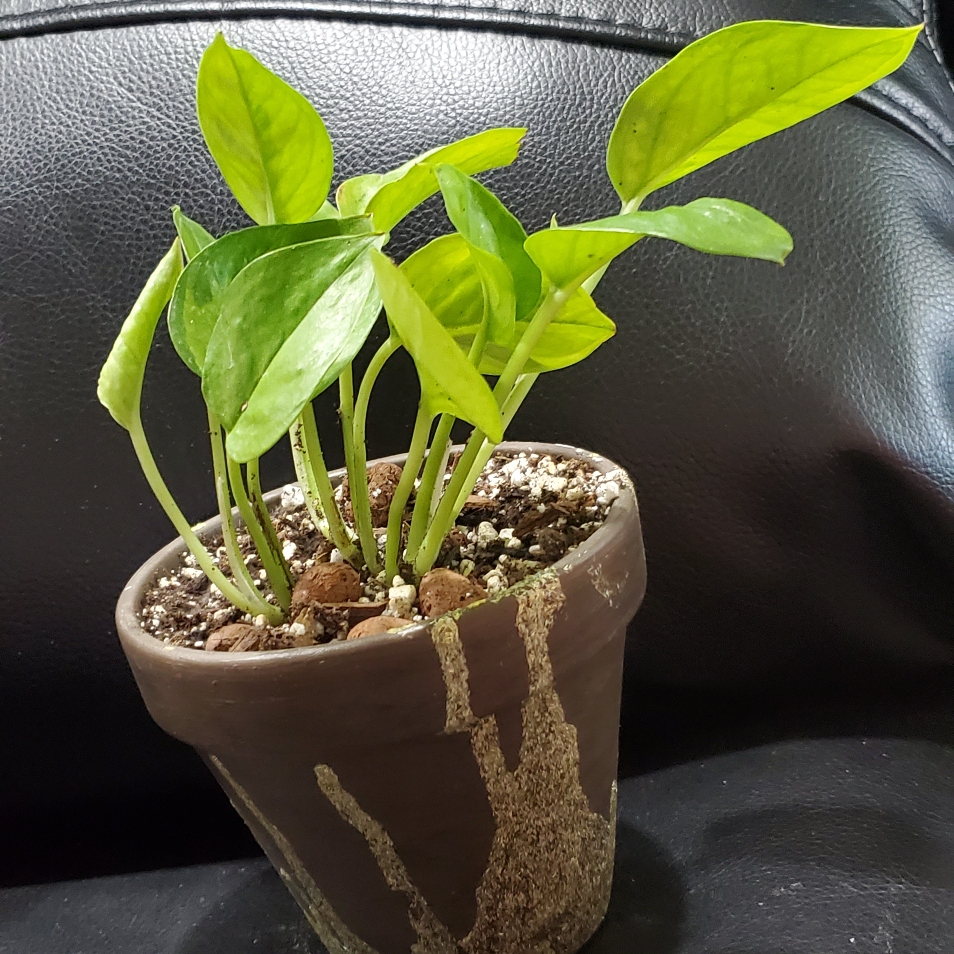
Epipremnum aureum 'Global Green'
Epipremnum 'Global Green'
Epipremnum is a genus of evergreen perennial climbing vines that originate from tropical forests in China, parts of Aisa, Australia and other parts of the Pacific. They have also been found to have naturalised in some parts of Africa, as well as Central and Southern America. They are in the Arum family, Araceae, where members are collectively referred to as Aroids. Epipremnum species are few, and they all are flowering plants exhibiting flowers typical of an arum with a spathe surrounding a spadix. Plants often grow very large and extensively through tree and forest canopies, where both juvenile and mature plants exist often showing differing leaf forms. Many are grown as houseplants in temperate climates, usually as juvenile plants, and they can show a variety of leave patterns and colours. Specifically, Epipremnum aureum is an evergreen perennial vine native to the Society Islands in French Polynesia, but is now found naturalised in many tropical and subtropical climates worldwide. Originally, and for many years, it was classified by botanists as Pothos aureus, hence why it is commonly referred to by many as 'Pothos', however it is no longer in the Pothos genus but the name often persists. It is also commonly known as Devil's Ivy. In the wild, it can grow up to 20 m tall, climbing by means of aerial roots which adhere to surfaces. However, as a houseplant its growth and size is significantly reduced, often requiring some form of support to grow around. It is also extremely rare to for it to flower. Leaves on plants typically grown indoors are small, waxy, heart-shaped, alternate along stems and entirely whole. Whereas on adult plants they often much larger and show irregular splits (pinnation). They are easy plants to grow as houseplants, being very popular, and can reach two meters or more. Leaves are typically green with golden or yellow streaking or marbling. 'Global Green' has green foliage with lime green variegation.
Contributed by @allyvon
-
Partial shade
-
Very little water
-
Not Frost hardy
-
Light and free draining
Common name
Epipremnum 'Global Green'
Latin name
Epipremnum aureum 'Global Green'
type
Evergreen Vine
family
Araceae
ph
5.0 - 7.5 Acid - Neutral
Plant & bloom calendar
-
Best time to plant
full grown dimensions
 1.00 M
2.00 M
1.00 M
2.00 M
Epipremnum aureum 'Global Green'
Epipremnum is a genus of evergreen perennial climbing vines that originate from tropical forests in China, parts of Aisa, Australia and other parts of the Pacific. They have also been found to have naturalised in some parts of Africa, as well as Central and Southern America. They are in the Arum family, Araceae, where members are collectively referred to as Aroids. Epipremnum species are few, and they all are flowering plants exhibiting flowers typical of an arum with a spathe surrounding a spadix. Plants often grow very large and extensively through tree and forest canopies, where both juvenile and mature plants exist often showing differing leaf forms. Many are grown as houseplants in temperate climates, usually as juvenile plants, and they can show a variety of leave patterns and colours. Specifically, Epipremnum aureum is an evergreen perennial vine native to the Society Islands in French Polynesia, but is now found naturalised in many tropical and subtropical climates worldwide. Originally, and for many years, it was classified by botanists as Pothos aureus, hence why it is commonly referred to by many as 'Pothos', however it is no longer in the Pothos genus but the name often persists. It is also commonly known as Devil's Ivy. In the wild, it can grow up to 20 m tall, climbing by means of aerial roots which adhere to surfaces. However, as a houseplant its growth and size is significantly reduced, often requiring some form of support to grow around. It is also extremely rare to for it to flower. Leaves on plants typically grown indoors are small, waxy, heart-shaped, alternate along stems and entirely whole. Whereas on adult plants they often much larger and show irregular splits (pinnation). They are easy plants to grow as houseplants, being very popular, and can reach two meters or more. Leaves are typically green with golden or yellow streaking or marbling. 'Global Green' has green foliage with lime green variegation.
Planting
From Early Spring TO Early Spring
Epipremnum is mostly sold as a potted houseplant and as such, you only need to repot them when the roots are are so congested the plant starts to suffer. The most obvious sign of this is when the leaves are drooping despite being well watered or the plant isn't growing any more. Use moist potting compost. Average light would be best for your plant. Growth will be slow if you choose a very dark spot, this will also create sparse "vines" with leaves quite far apart. Very bright spots will eventually destroy the plant. No lower than 10°C / 50°F in Winter and ideally between 18°C - 24°C / 65°F - 75°F in the other seasons.
Propagation by cuttings
From Early Spring TO Late Summer
Propagating Epipremnum is really easy. Cut off the tips to create cuttings and either put them in water until they grow roots, or push the cuttings directly into pots of moist compost. They root easily so you should have a good success rate.



















